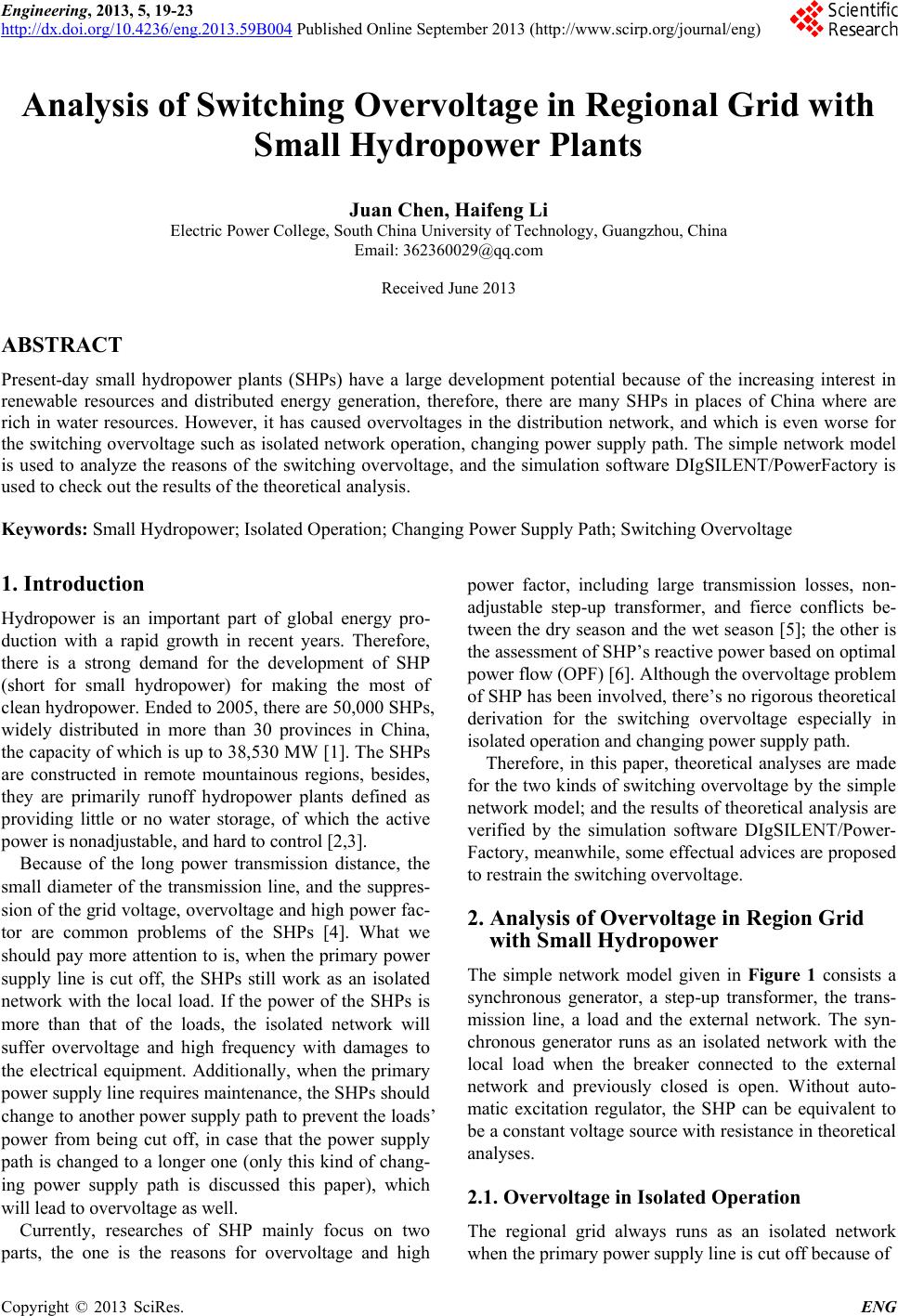
Engineering, 2013, 5, 19-23
http://dx.doi.org/10.4236/eng.2013.59B004 Published Online September 2013 (http://www.scirp.org/journal/eng)
Copyright © 2013 SciRes. ENG
Analysis of Switching Over voltage in Regional Grid with
Small Hydropower Plants
Juan Chen, Haifeng Li
Electric Power College, South China University of Technology, Guangzhou, China
Email: 362360029@qq.com
Received June 2013
ABSTRACT
Present-day small hydropower plants (SHPs) have a large development potential because of the increasing interest in
renewable resources and distributed energy generation, therefore, there are many SHPs in places of China where are
rich in water resources. However, it has caused overvoltages in the distribution network, and which is even worse for
the switching overvoltage such as isolated network operation, changing power supply path. The simple network model
is used to analyze the reasons of the switching overvoltage, and the simulation software DIgSILENT/PowerFactory is
used to check out the results of the theoretical analysis.
Keywords: Small Hydropower; Isolated Operation; Changing Power Supply Path; Switching Overvoltage
1. Introduction
Hydropower is an important part of global energy pro-
duction with a rapid growth in recent years. Therefore,
there is a strong demand for the development of SHP
(short for small hydropower) for making the most of
clean hydropower. Ended to 2005, there are 50,00 0 SHPs,
widely distributed in more than 30 provinces in China,
the capacity of which is up to 38,530 MW [1]. Th e SHPs
are constructed in remote mountainous regions, besides,
they are primarily runoff hydropower plants defined as
providing little or no water storage, of which the active
power is nonadjustable, and hard to control [2,3].
Because of the long power transmission distance, the
small diameter of the transmission line, and the suppres-
sion of the grid voltage, overvoltage and high power fac-
tor are common problems of the SHPs [4]. What we
should pay more atte ntion to is, when the primary power
supply line is cut off, the SHPs still work as an isolated
network with the local load. If the power of the SHPs is
more than that of the loads, the isolated network will
suffer overvoltage and high frequency with damages to
the electrical equipment. Additionally, when the primary
power supply line requires maintenance, the SHPs should
change to another power supply path to prevent the loads’
power from being cut off, in case that the power supply
path is changed to a longer one (only this kind of chang-
ing power supply path is discussed this paper), which
will lead to overvoltage as well.
Currently, researches of SHP mainly focus on two
parts, the one is the reasons for overvoltage and high
power factor, including large transmission losses, non-
adjustable step-up transformer, and fierce conflicts be-
tween the dry season and the wet season [5]; the other is
the assessment of SHP’s reactive power based on optimal
power flow (OPF) [6]. Although the overvoltage problem
of SHP has been involved, there’s no rigorous theoretical
derivation for the switching overvoltage especially in
isolated operation and changing power supply path.
Therefore, in this paper, theoretical analyses are made
for the two kinds of switching overvoltage by the simple
network model; and the results of theoretical analysis are
verified by the simulation software DIgSILENT/Power-
Factory, meanwhile, some effectual advices are proposed
to restrain the switching overvoltage.
2. Analysis of Overvoltage in Region Grid
with Small Hydropower
The simple network model given in Figure 1 consists a
synchronous generator, a step-up transformer, the trans-
mission line, a load and the external network. The syn-
chronous generator runs as an isolated network with the
local load when the breaker connected to the external
network and previously closed is open. Without auto-
matic excitation regulator, the SHP can be equivalent to
be a constant voltage source with resistance in th eoretical
analyses.
2.1. Overvoltage in Isolated Operation
The regional grid always runs as an isolated network
when the primary po we r s u pply line is c ut off becau se of